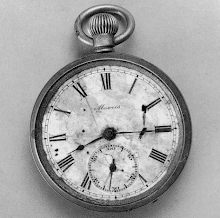More than 80 affected communities and organizations from across the U.S. have joined together to support federal legislation that will require the Department of Defense and the Department of Energy to comply with laws designed to protect human health and the environment ... Also known as the "Military Environmental Responsibility Act," the bill seeks to eliminate military waivers to key environmental laws ... The Department of Defense is responsible for more than 31,000 cleanup sites on more than 4,600 active and former defense properties. About one in 10 Americans - nearly 29 million - live within 10 miles of a military site that is listed as a national priority for hazardous waste cleanup under the federal Superfund program.
Common Dreams.org
March 23, 2009
Mar 28, 2009
Mar 23, 2009
University Stonewalls Army Corps Request for World War I Archives
At a standing room only, work-in-progress screening of her forthcoming documentary, Academy-award nominated filmmaker Ginny Durrin chronicled sixteen years of uncertainty following discovery of buried chemical munitions in the Spring Valley neighborhood of Washington, DC. During a panel discussion after seeing Bombs In Our Backyard, US Army Corps historian Mark Baker charged that the University was still blocking access to its own "confidential" archives --- records that could shed light on the existence and whereabouts of additional weapon disposal pits.
.jpg) Charlie Bermpohl & Mark Baker (3/19/09)
Charlie Bermpohl & Mark Baker (3/19/09)
.jpg) Charlie Bermpohl & Mark Baker (3/19/09)
Charlie Bermpohl & Mark Baker (3/19/09)
"The university sent memos in December of 2008 to individuals who attended classes or worked in areas near the pit three dig, said Bethany Bridgham, the senior associate general counsel in AU's legal office. Nearby buildings included Watkins, Kreeger, Hamilton and Financial Aid. The memo provided details about AU's safety precautions and gave instructions for setting up sealed shelters in the event of a chemical leak. The university has also set up a Web site at american.edu/usace to keep students updated on the status of the investigations. The last updates on the Web site as of press time were from July 14, when the university gave information about an arsenic soil cleanup operation in the area between Hughes and McDowell Halls."
Mar 15, 2009
Hunt for Missing Munitions Moves to Dalecarlia Woods this Summer

Remnants of narrow gauge railway tracked in yellow (above)
In 2002, USACE was notified of a potential AUES-related discovery in Dalecarlia Woods. Rick Woods reported that in 1984, he discovered and removed a pile of approximately 55 munition items in Dalecarlia Woods while looking for Civil War relics. He also reported that glassware was present. In 2005, a site visit was conducted to identify the location of the Rick Woods Area. Rick Woods accompanied the Spring Valley Area of Interest Task Force and identified the site where he thought the munition items were located, using remnants of a narrow gauge railway as a point of reference. This area was designated as AOI 2 (Rick Woods Area).Restoration Advisory Board Meeting Minutes
January 13, 2009 (pg. 8)
Anomaly removals for the 3 half-acre grids are tentatively scheduled for summer 2009, followed by complete geophysical mapping of the remaining acreage (54.5 acres) and associated anomaly investigations. The geophysical survey will include the locations of AOI 2 (Rick Woods Area) and AOI 6 (Dalecarlia Woods Impact Area) along with buffer areas surrounding the AOIs. T. Beckwith showed a map of the upcoming geophysical survey area, featuring the locations of the [Livens] Range Fan, AOI 2 (Rick Woods Area), AOI 6 (Dalecarlia Woods Impact Area), the 3 half-acre grids surveyed in 2007, and munition items found during the 1994 Zone 9 investigation.
Restoration Advisory Board Meeting Minutes
January 13, 2009 (pg. 10)
Restoration Advisory Board Meeting Minutes
January 13, 2009 (pg. 10)
Mar 10, 2009
Tons of Chemical Weapons Scattered Across Ocean Floor
The University of Hawai'i yesterday said it has found "hundreds" of munitions on the ocean floor about six miles south of Pearl Harbor, as it continues to use deep-diving submersibles to search for tons of chemical weapons dumped during and after World War II ... 2,558 tons of chemical agents were dumped at three deep-water sites off O'ahu, including lewisite, mustard, cyanogen chloride and cyanide.
... A towed detection system was used in 2007 to look at 40 square miles of ocean bottom at the site south of Pearl Harbor from about 150 to 200 feet above the sea floor. Rows of "black dots" that appeared were investigated further to identify munitions that were rolled off the sides of barges.
Honolulu Advertiser ~ (March 10, 2009)Mar 1, 2009
Army Will Neutralize 90-Year-Old WMD's in Woods Next to Reservoir
.jpg) The U.S. Army Corps of Engineers is planning to safely destroy all of the chemical munitions recovered at the Pit 3 project area. This involves safely treating and neutralizing the chemical agent fill from the recovered World War I military chemical munitions. USACE plans to use a mobile system, known as the Explosive Destruction System to destroy the munitions on federal property at a site adjacent to our storage facility in the May 2009 timeframe.
The U.S. Army Corps of Engineers is planning to safely destroy all of the chemical munitions recovered at the Pit 3 project area. This involves safely treating and neutralizing the chemical agent fill from the recovered World War I military chemical munitions. USACE plans to use a mobile system, known as the Explosive Destruction System to destroy the munitions on federal property at a site adjacent to our storage facility in the May 2009 timeframe.
IHF behind Sibley Hospital (slide #20)
Spring Valley FUDS
The chemical weapons will be destroyed "in place" at the US Army Corps of Engineeers' Interim Holding Facility (IHF) on federal land around Dalecarlia Reservoir. This land is 410 feet from Spring Valley residences, 860 feet from the Dalecarlia Reservoir and 985 feet from Sibley Hospital.
RAB Meeting Minutes
February 10, 2009 (pg. 6 - 7)
Subscribe to:
Posts (Atom)
.jpg)









